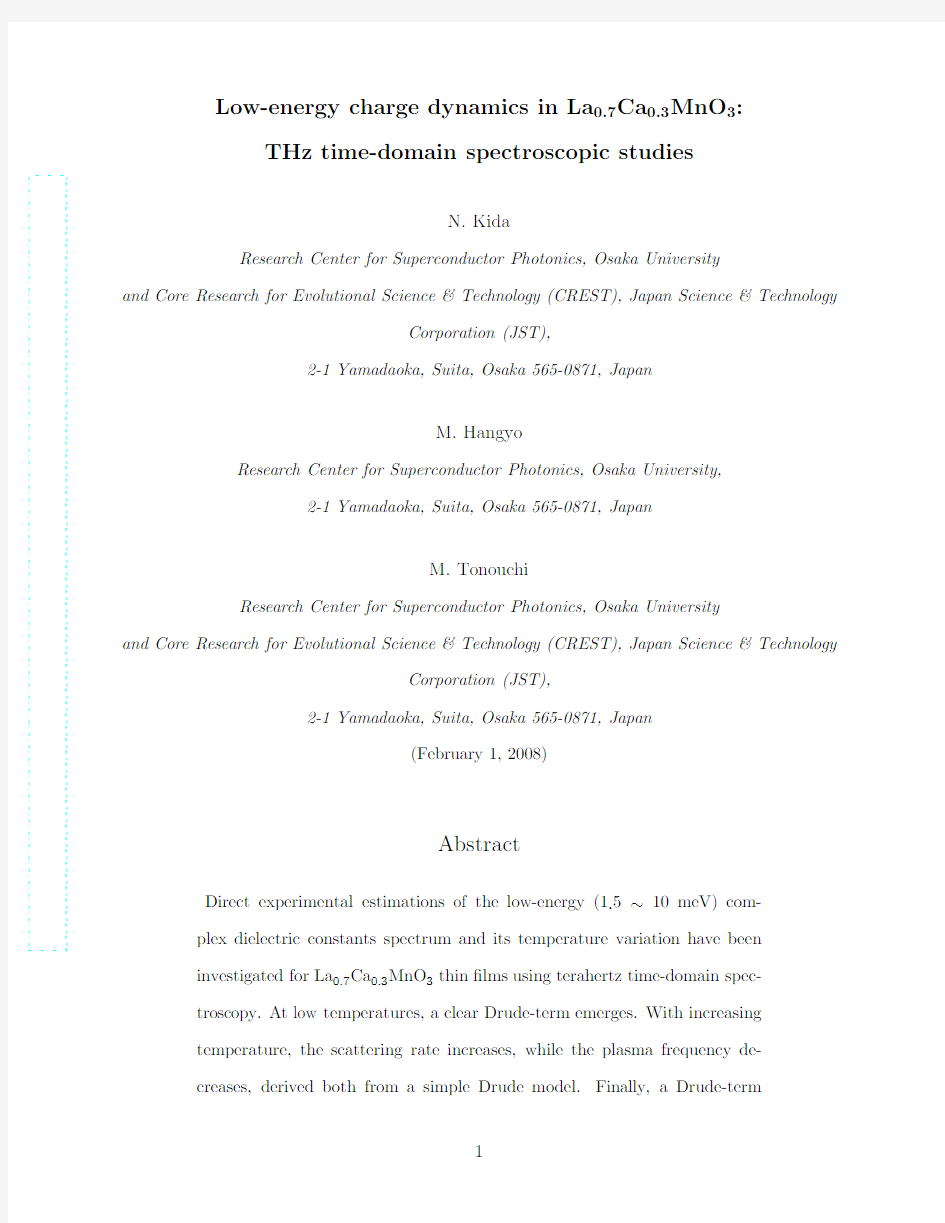Low-energy charge dynamics in La$_{text{0.7}}$Ca$_{text{0.3}}$MnO$_{text3}$ THz time-domain


a r X i v :c o n d -m a t /0005461v 2 [c o n d -m a t .m t r l -s c i ] 11 S e p 2000Low-energy charge dynamics in La 0.7Ca 0.3MnO 3:
THz time-domain spectroscopic studies
N.Kida Research Center for Superconductor Photonics,Osaka University and Core Research for Evolutional Science &Technology (CREST),Japan Science &Technology Corporation (JST),2-1Yamadaoka,Suita,Osaka 565-0871,Japan M.Hangyo Research Center for Superconductor Photonics,Osaka University,2-1Yamadaoka,Suita,Osaka 565-0871,Japan M.Tonouchi Research Center for Superconductor Photonics,Osaka University and Core Research for Evolutional Science &Technology (CREST),Japan Science &Technology Corporation (JST),2-1Yamadaoka,Suita,Osaka 565-0871,Japan (February 1,2008)Abstract Direct experimental estimations of the low-energy (1.5~10meV)com-plex dielectric constants spectrum and its temperature variation have been
investigated for La 0.7Ca 0.3MnO 3thin ?lms using terahertz time-domain spec-
troscopy.At low temperatures,a clear Drude-term emerges.With increasing
temperature,the scattering rate increases,while the plasma frequency de-
creases,derived both from a simple Drude model.Finally,a Drude-term
submerges well below the insulator-metal transition temperature.On the
basis of the present results,low-energy charge dynamics are discussed.
78.20.Ci,71.30.+h
Typeset using REVT E X
Hole-doped manganites,general formula A1?x B x MnO3(where A is a trivalent rare-earth element and B a divalent element such as Sr or Ca),exhibit a rich variety of electronic and magnetic properties and versatile intrigued phenomena such as colossal magnetoresistance (CMR).1,2One of the most important goal in this?eld is the achievement of understandings of the anomalous state near the insulator-metal(IM)phase boundary,because the con-ventional CMR e?ect appears around the IM transition temperature(T IM).A number of research e?orts have been focused on the paramagnetic insulating phase of La0.7Ca0.3MnO3 and revealed the essential ingredient for the occurrence of the CMR e?ect;Jahn-Teller small polaron process,3,4in addition to the traditionally well known,double-exchange process.On the other hand,the ferromagnetic metallic phase is not well clari?ed.
In this Communication,low-energy(1.5~10meV)charge dynamics of La0.7Ca0.3MnO3 thin?lms in the ferromagnetic metallic phase have been investigated by means of terahertz (THz)time-domain spectroscopy(TDS)with transmission con?guration.
Optical spectroscopy has given useful information of the electronic structure in the strong correlated electron system.Experimental studies based on temperature-dependent optical conductivity spectra have shown anomalous features of manganites as?rstly demonstrated by Okimoto et al.;the100%spin polarized half-metallic nature in the ferromagnetic metallic phase,5the large spectral weight change up to several eV with temperature and magnetic ?eld,5,7–16and a small Drude weight with the incoherent part background.5,6,8,14,17 The?rst point is well established directly by spin-polarized photoemission spectroscopy.18 The second one is understood in terms of the large spectral weight transfer from the inter-band transition to the exchange-split e g-bands,as spin being perfectly polarized.However, last one,low-energy charge dynamics are still far from being understood and controversial under several groups.For example,a sharp Drude-term below the optical phonon energy with nearlyω-independent?at incoherent part have been observed in La1?x Sr x MnO35,8and La0.7Ca0.3MnO3,6,10although the estimated e?ective mass is large compare to one from the speci?c heat measurement.19,20On the contrary,Takenaka et al.have claimed that a sharp Drude-term falls on the incoherent part in La1?x Sr x MnO3,when the cleaved surface
is used.15,16
Most experimental demonstrations have been done using Kramers-Kronig(KK)trans-formation to estimate complex optical spectra.The method of this type su?ers from the fact that the low-energy spectrum is deduced from extrapolation using the DC resistivity or Hagen-Rubens relation in order to execute KK transformation.On the contrary,using TDS technique,direct measurements of time pro?le of the transmission amplitude yields both real and imaginary parts of complex optical spectra without KK transformation.In addi-tion to the above advantage,the THz beam is suitable for the observation of a Drude-term in the metallic phase.They overcome the di?culty of detailed discussions in the low-energy region,which are limited to far-infrared spectroscopy as mentioned above.We carefully analyzed the data of dielectric constant spectra of La0.7Ca0.3MnO3thin?lms by a simple Drude model including the plasma frequency and the scattering rate as parameters.We focus on their temperature dependence in the ferromagnetic metallic phase and discuss the low-energy charge dynamics with a comparison of the various spectroscopic studies.
The sample investigated here is La0.7Ca0.3MnO3thin?lm,deposited on MgO(100)sub-strate by pulsed laser deposition technique.The obtained?lm is a-axis oriented and has a lattice constant of3.86?A,evaluated from room temperature X-ray di?raction pro?le.T IM is about230K according to the temperature dependence of the resistivity measurement [see,the inset of Fig.3(a)].The surface of the nondoped InAs wafer is excited by the femtosecond laser pulses from a mode-locked Ti:Sapphire laser emitting a50fs pulses at800 nm to produce the THz beam.Transmitted THz radiation through the sample is detected by the bow-tie-type low temperature grown GaAs photoconductive switch.The waveform of the radiation is obtained by scanning the time https://www.360docs.net/doc/993391132.html,ly,we get information of the transmission amplitude as well as phase shift without KK transformation.In order to minimize experimental errors,we repeated the same procedure3~6times at respective temperatures.
The TDS geometry of thin?lm deposited on MgO substrate is shown in Fig. 1.We ignore the multiple re?ectance inside MgO.The complex transmission coe?cient of MgO
can be written as
t ′=t 3t ′3exp[?i (k 2?k 0)d ′],(1)
where d ′is the thickness (~0.5mm)of MgO,t 3=2N 2/(1+N 2)is the transmission coe?cient from MgO to air,t ′3=2/(2N 2+1)is the transmission coe?cient from air to MgO,k 2the wavenumber of MgO,k 0the vacuum wavenumber,and N 2the complex refractive indices of MgO.The complex transmission coe?cient of ?lm/MgO can be written as
t =t 1t 2t 3exp {?i [k 1d +k 2d ′?k 0(d +d ′)]}
t ′3exp[?i (k 1?k 0)d ]
A ′exp[i (θ?θ′)],(3)
where A and θare the amplitude and the phase shift of the transmission of ?lm/MgO,respectively.A ′and θ′are those of the transmission of MgO,respectively.N 1can be numerically calculated in eq.
(3)using experimentally determined values;A ,A ′,θ,and θ′.Figure 2shows the imaginary part of dielectric constant spectra [?2(ω)]below 10meV at various temperatures in the ferromagnetic metallic phase.Open circles are experimental data.The power spectrum of the THz source used in this experiment is shown in Fig.2as the dashed line.Re?ecting the metallic character,?2shows a steep increase with decreasing photon energy and a Drude peak centered at ˉh ω~0is clearly seen at 16K.With increasing temperature,the intensity of a Drude-term decreases and is not seen above 170K (~0.7T IM ).It is noticed that this temperature is well below T IM measured by the conventional four-probe method as shown in the inset of Fig.3(a).For quantitative discussions,we applied a simple
Drude model.A simple Drude model including two parameters,the plasma frequency(ωp) and the scattering rate(Γ),
?2(ω)=Γω2p
ω
(4)
has been previously given the?t of the optical conductivity spectrum.5,7,8,10,13–16The solid curves are least-squares?t to experimental data using eq.(4).We found that the dielectric response between16and144K is successfully explained by a simple Drude model.We obtainωp~1.6eV andΓ~100meV at16K.The value ofωp is consistent with the previous far-infrared spectroscopic result of La0.7Ca0.3MnO3thin?lm deposited on LaAlO3 substrate by Simpson et al.17However,the value ofΓis found to be5-times larger than that of Simpson et al.(Γ~20meV).At low temperatures,the impurity scattering is the major factor of great in?uence inΓ.The value of the residual resistivity is a good measure of the strength of the impurity scattering;our sample has the residual resistivity about300μ?cm,which is3-times larger than the value reported by Simpson et al.Therefore,this discrepancy mainly originates from the crystal quality between two samples.
To quantify the spectral change with temperature,we plotted in Fig.3,the temperature dependence of(a)the resistivity,(b)Γ,and(c)ωp below200K.As clearly seen,a Drude-term submerges above170K.With increasing temperature,Γincreases in proportion to T2below160K,as indicated by the solid line in Fig.3(b).But the clear deviation of Γfrom the T2-term can be seen above160K.Accordingly,the temperature dependence of the resistivity has the T2-term as described later.This rise ofΓhas been reported by Simpson et al.17However,the T2-coe?cient is more pronounced when compared to Simpson et al.In contrast to the intuitive view of conventional metals,ωp decreases with increasing temperature as shown in Fig.3(c).It suggests that m?and/or the carrier density have the temperature dependence in the ferromagnetic metallic phase.
It is well known that all the resistance in the ferromagnetic metal is described by the Matthiessen’s rule expressed as
ρ(T)=ρ0+AT2+BT9/2,(5)
whereρ0is the residual resistivity,the T2-term the electron-electron scattering process, and the T9/2-term the electron-magnon scattering process as introduced by the double-exchange model.21The temperature dependence of the resistivity[1/σ1(0)]from the following relationship is represented by closed circles as shown in Fig.3(a).
ωp= ?0,(6) where?0is the permittivity of vacuum.The dashed line is a least-squares?t using eq.(5) to the following data;ρ0=3.2×10?4?cm,A=1.5×10?8?cm/K2,and B=1.9×10?13?cm/K9/2.As previously reported,the metallic phase is well described by the?rst-and second-terms in eq.(5).19,20,22We also performed the?t using only T2-term as shown by the solid line.Both lines hold well with the experimental data below100K.These result indicates that the scattering process is dominated by only the electron-electron scattering process,and the electron-magnon and/or the lattice contributions are less important in the ferromagnetic metallic phase below100K.23It is mentioned that the submergence of the Drude-term,characterized by1/σ1(0)andΓ,coincides with clear deviations above160K from?tting curves as shown in Figs.3(a)and(b).
As a convenience,we classi?ed the electronic state into three categories below300K as shown in the inset of Fig.3(a).Below~0.7T IM,a clear Drude-term emerges in the ferromagnetic metallic phase(phase-I).We call phase-II between~0.7T IM and T IM,in which a Drude-term is not seen,whileρshows the metallic conduction(dρ/dT>0).The polaron hopping regime in the paramagnetic insulating phase(phase-III)is widely reported.3,4,24 This classi?cation is recently proposed to clear the electronic state of La0.825Sr0.175MnO3by Takenaka et al.16,25
To get insights into features of charge carriers in phase-I,it is important to estimate the e?ective mass(m?).We assume the carrier density(n)of1.6holes per Mn-site according to the Hall e?ect measurement by Chun et al.24At16K,m?is estimated to be~15in units of the bare electron mass(m0),which can be given by the relationship m?/m0=e2n/(?0ω2p m0). This value is few-times larger than one obtained from the speci?c heat measurement,20which
is simply ascribed to that the motion of charge carriers has the incoherent nature even in the ferromagnetic metallic ground-state.
It was recently shown that the electronic speci?c heat constant of La1?x Ca x MnO3linearly depending on m?,shows the less mass renormalization near the insulator-metal critical point (x c~0.22),20in contrast to other hole-doped transition metal oxides showing the large mass renormalization e?ect.We also measured the complex optical spectrum near x c using THz TDS technique at20K.26Despite the fact that the magnitude of m?derived from THz TDS technique is considerably di?erent from one in speci?c heat measurements as described above,no signi?cant enhancement of m?is also observed in our spectroscopic studies;we derivedωp~1.3eV and obtained m?~23m0near x c in the ferromagnetic metallic ground-state.
These incoherent characteristics of the charge carriers showing a small Drude weight in manganites are?rstly reported by Okimoto et al.;5,8to the best of our knowledge,all values of m?in La1?x Sr x MnO3and La0.7Ca0.3MnO3reported previously are inconsistent with that estimated from speci?c heat measurements19,20except for the results of Takenaka et al.15,16They have claimed that a Drude weight is not a small when the cleaved surface is used.On the contrary,recent careful photoemission spectroscopic studies using the cleaved surface revealed that the spectral weight is reduced at Fermi-level due to the formation of the pseudo-gap.27These controversial results are not clear at present.
Other important physical quantities at low temperatures are the mean free-path(l)and the Fermi wavelength(λF).We obtain l~4.7?A,via the relation l=ˉh/(Γm?)(6π2n/p)1/3, where p(=2)is the degeneracy.Assuming the spherical Fermi surface,λF[=(8π/3n)1/3]is estimated to be~6.7?A.Therefore,the conditionλF~l>a(lattice constant)is derived even in the ferromagnetic metallic ground-state.This is in contrast to the conventional picture of ordinary metals,in which the conditionλF as evidenced by the fact thatρ(T)is well described in eq.(5).
